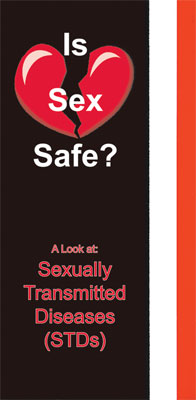Is Sex Safe?
Editor’s Note: Please visit our home page for a full listing of abortion facts.
 Is a sexual experience worth… your health? Your life? Consider these facts concerning STDs:
Is a sexual experience worth… your health? Your life? Consider these facts concerning STDs:
- STDs are the most common diseases in America next to the common cold and flu.
- More than 1 in 5 Americans are presently infected with an STD.
- 19 million people become newly infected with STDs yearly – 52,000/day.
- One fourth of STD infections occur in teens and two thirds of them occur in people under the age of 25.
- 65 million Americans are infected with an incurable STD.
- 35 – 50 different kinds of STDs exist, 25 of which occur commonly.
- 20 different STDs are rampant among the young. At least 25 STDs are spread primarily through sexual contact.
- STDs infect 4.75 million teenagers each year, over 13,000 new cases per day.
- 80% infected with an STD do not develop the initial symptoms.
- STDs are contagious even though no symptoms exist.
- New strains of STDs are resistant to treatment.
- STDs often cause chronic pain and permanent damage.
- STD infection can increase the possibility of contracting AIDS.
- Some STDs are incurable, life-long infections. Some can lead to life-threatening diseases and even death.
If you are involved sexually… you need to know the risks!
- Your partner may not know he/she has an STD…. 80% infected do not know their condition.
- Your partner may not tell you the truth if he/she has been sexually active in the past.
- You can have an STD and have no symptoms for weeks, months, possibly years. STDs are contagious even though no symptoms exist.
- Teens are much more susceptible to STD damage because they have a lower level of antibodies than adults.
- It is extremely important to see a doctor for a check-up if you – or your partner – have had a sexual experience outside of marriage even though no symptoms exist.
- According to the Centers for Disease Control, condoms do not provide complete protection from any STD OR pregnancy. Infection can occur in both males and females whether or not a condom is used.
Avoid the risks… save sex for marriage!
According to the Centers for Disease Control and Prevention (CDC), the surest way to avoid pregnancy or any infection with a sexually transmitted disease is to practice sexual abstinence (abstain from any sexual contact) while single. If you marry, select a partner who is not infected with an STD and remain sexually faithful during marriage.
Women with STDs suffer greater physical trauma than men. An infant born to a mother who has an STD is also at risk of contracting the disease during birth. A newborn can contract an STD while breast-feeding if the mother is infected. STDs should not be taken lightly. Most are curable with antibiotics or at least can be treated.
Presently AIDS is the only STD routinely fatal to those infected. Do not let any symptom or question go unchecked. We encourage all to postpone sexual activity until marriage.
Some final considerations
If you engage in premarital sexual activity:
- You are very likely to contract an STD.
- You may not realize you have an STD until it’s “too late.”
- You could be legally liable if you infect someone.
If you discover that you have an STD:
- You need treatment immediately.
- You must stop sexual activity.
- You need to notify all sexual partners.
References
- ^ Centers for Disease Control and Prevention, National Center for HIV, STD and TB Prevention, Divisions of HIV/AIDS Prevention, Workshop Summary: Scientific Evidence on Condom Effectiveness for Sexually Transmitted Disease (STD) Prevention June 12-13, 2000, found at: http://www.niaid.nih.gov/dmid/stds/condomreport.pdf (a review of 138 scientific studies concerning condom effectiveness published July 20, 2001), accessed 8-16-2006.
- ^ Centers for Disease Control and Prevention, National Center for HIV, STD and TB Prevention Division of Sexually Transmitted Diseases, Fact Sheets found at: http://www.cdc.gov/nchstp/dstd/disease_info.htm, accessed 8-16-2006.
- ^ Centers for Disease Control and Prevention, National Center for Infectious Diseases, Division of Parasitic Diseases, Trichomonas Fact Sheet, revised 9-24-04, found at: http://www.cdc.gov/ncidod/dpd/parasites/trichomonas/factsht_trichomonas.htm, accessed 8-16-2006.
- ^ Centers for Disease Control and Prevention, National Center for Infectious Diseases, Viral Hepatitis B, Fact Sheet, reviewed 6-24-2006, found at: http://www.cdc.gov/ncidod/diseases/hepatitis/b/fact.htm, accessed 8-16-2006.
- ^ Centers for Disease Control and Prevention, National Center for Infectious Diseases, Viral Hepatitis C, Fact Sheet, reviewed 6-24-2006, found at: http://www.cdc.gov/ncidod/diseases/hepatitis/c/fact.htm, accessed 8-16-2006.
- ^ Centers for Disease Control and Prevention. Sexually Transmitted Disease Surveillance, 2004. Atlanta, GA: U.S. Department of Health and Human Services, September 2005.
